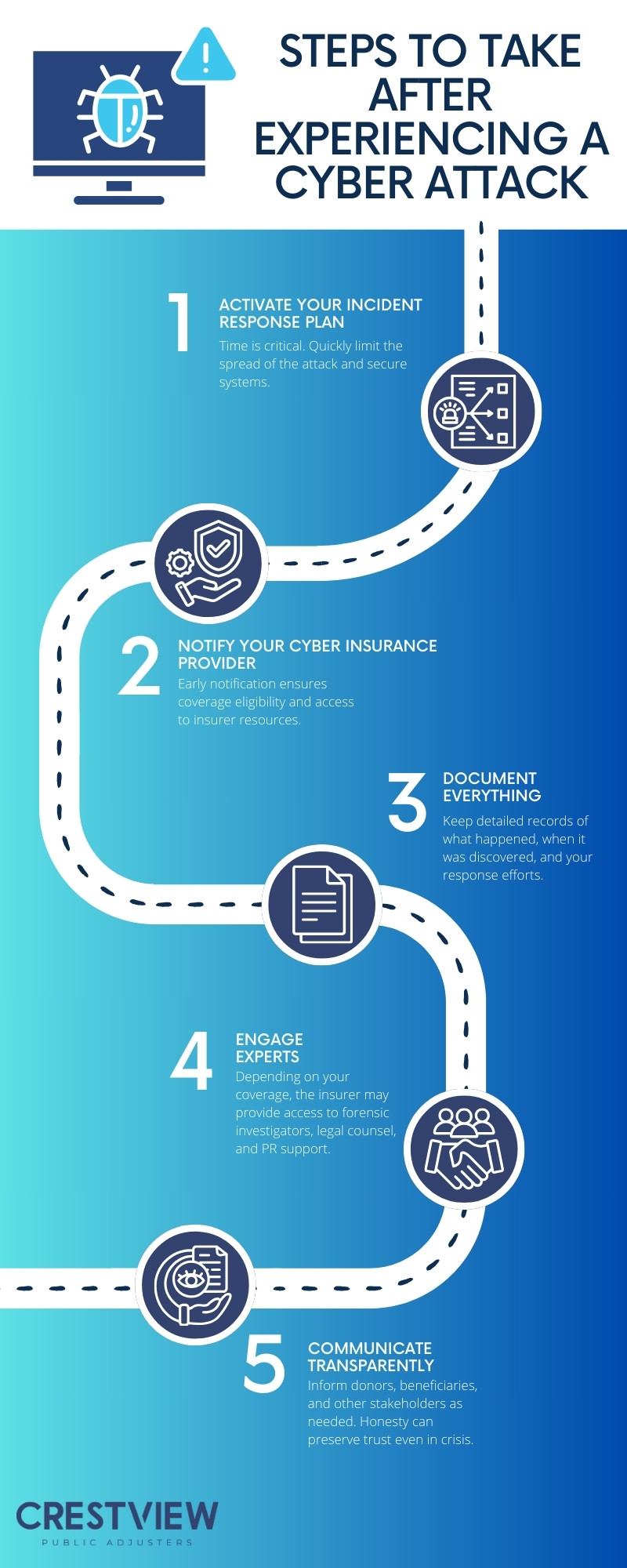Key Points:
- Nonprofits and charities face growing risks of cyberattacks, making cyber insurance crucial.
- Cyber insurance for nonprofits covers expenses like data breach response, legal costs, and ransomware payments.
- Crestview Public Adjusters helps nonprofit organizations in New Jersey, New York, and Florida with cyber insurance claims.
Cybercrime doesn’t discriminate—and nonprofits are not immune. Given their tight budgets and sensitive donor data, nonprofits and charities must protect themselves against digital threats just like any for-profit organization. Before we dive deeper into the topic, let’s answer the essential query directly.
What is Cyber Insurance for Nonprofits and Charities?
Cyber insurance for nonprofits and charities provides financial protection against losses related to cyber incidents such as data breaches, ransomware attacks, and network failures. This specialized insurance covers response costs, legal fees, regulatory penalties, and damage to reputation.
Securing cyber insurance means nonprofits can recover faster and with less financial hardship after an attack, safeguarding both their mission and the trust of their communities.
Why Do Nonprofits and Charities Need Cyber Insurance?
Nonprofits often handle a large amount of sensitive information, including donor records, financial data, and beneficiary details. At the same time, many operate with limited cybersecurity resources, making them a prime target for hackers.
Unlike corporations, charities rarely have the reserve funds to bounce back from a devastating cyber incident. That’s where cyber insurance for nonprofits becomes a strategic necessity, not a luxury.
Some of the unique vulnerabilities nonprofits face include:
- Limited IT security budgets: Smaller organizations can’t always afford the latest security tech.
- High-value donor data: Cybercriminals see donor databases as lucrative targets.
- Staff turnover: Volunteers and temporary staff can unintentionally increase exposure to risks.
- Regulatory compliance: Even nonprofits must adhere to data protection laws, with heavy fines for noncompliance.
Without cyber insurance, a single incident could cripple operations or permanently damage public trust.
What Does Cyber Insurance for Nonprofits Typically Cover?
Understanding the scope of a policy is critical before purchasing coverage. Cyber insurance policies for nonprofits usually include several key protections, tailored to the specific needs of charitable organizations.
Here’s a closer look at common areas of coverage:
- Data Breach Response – Covers expenses like forensic investigations, notifying affected parties, setting up credit monitoring, and managing PR crises.
- Cyber Extortion and Ransomware – Pays ransom demands (if legally allowed) and covers negotiation costs when systems are held hostage.
- Third-Party Liability – Protects against lawsuits filed by donors, clients, or partners who are affected by a cyber incident involving your organization.
- Business Interruption – Reimburses lost income and extra expenses incurred while recovering from an attack.
- Regulatory Defense and Penalties – Helps pay for legal defense and any fines or penalties stemming from breaches of data privacy laws.
Not every cyber policy is created equal. That’s why it’s crucial for nonprofits to carefully evaluate what each policy offers before making a decision.
Common Cyber Threats Faced by Nonprofits
Cyber threats are evolving rapidly, and nonprofits must understand what they’re up against. While the threats are similar to those facing businesses, nonprofits face additional layers of vulnerability.
Some of the most common cyber risks include:
- Phishing Scams – Fake emails pretending to be from trusted sources can trick employees into revealing passwords or transferring funds.
- Ransomware Attacks – Cybercriminals encrypt critical data and demand hefty ransoms for its release.
- Internal Threats – Sometimes, the threat comes from within. Poor password hygiene or unintentional mishandling of sensitive information can lead to breaches.
- Third-Party Breaches – Vendors or contractors with access to nonprofit systems can become points of vulnerability if their security standards are weak.
- Website Defacement – Hackers sometimes target nonprofit websites to spread misinformation or damage reputations.
Recognizing these threats is the first step to mitigating them—and a strong cyber insurance policy acts as a final safety net when other defenses fail.

How Much Does Cyber Insurance for Nonprofits Cost?
The cost of cyber insurance for nonprofits can vary widely based on several factors. Unlike other insurance types with more predictable premiums, cyber coverage depends heavily on the organization’s digital footprint and risk profile.
Factors influencing the price include:
- Organization size and annual revenue – Larger nonprofits typically pay more due to higher exposure.
- Type of data collected and stored – Sensitive health, donor, or beneficiary information increases risk—and premiums.
- Existing cybersecurity measures – Organizations with robust cybersecurity protocols in place may qualify for lower rates.
- Claims history – A nonprofit that has suffered previous incidents could see higher costs.
Typical premiums can range from $750 to $3,500 annually, but larger organizations or those in high-risk categories could pay significantly more. It’s also important to factor in deductibles and coverage limits when evaluating the overall cost.
How to Choose the Right Cyber Insurance for Your Nonprofit
Selecting a cyber insurance policy isn’t just about picking the cheapest option. Nonprofits need to assess their risks carefully and find coverage that truly fits their needs. Start by conducting a cyber risk assessment to identify vulnerabilities, including the type and volume of sensitive data your organization handles. Then, take time to understand policy details—know exactly what’s covered, what’s excluded, and be sure to ask about sub-limits, retentions, and endorsements. It’s also important to compare multiple quotes by working with an insurance advisor experienced in nonprofit risks, ensuring you gather competitive and appropriate offers.
Beyond just price and coverage, consider the claims process and prioritize insurers known for excellent customer service and claims handling. Look for policies that offer flexibility, so coverage can adapt as your organization grows or changes its data practices. Many cyber insurance policies also include pre-breach services like cybersecurity training, which can be a valuable tool to strengthen your defenses. Careful selection ensures that when a crisis hits, your insurance acts as a reliable support system rather than a source of added confusion.
Steps Nonprofits Should Take Before Buying Cyber Insurance
Before rushing to buy a policy, nonprofits can take several important preparatory steps to lower premiums and strengthen their defenses. Implementing strong access controls by limiting system access based on roles and responsibilities is a key starting point. Providing regular cybersecurity training helps educate employees and volunteers on identifying and avoiding cyber threats. Using data encryption to protect sensitive information both in transit and at rest is another essential measure. It’s also important to create an incident response plan, ensuring there is a documented strategy for responding to breaches quickly and effectively. Finally, keeping software updated and patched helps fix known security vulnerabilities that could otherwise be exploited.
Taking these proactive steps, nonprofits demonstrate a serious commitment to cybersecurity. Insurance companies are more likely to offer favorable terms to organizations that show they have strong protections already in place. A little preparation can go a long way toward making insurance more affordable—and strengthening the nonprofit’s overall security posture.
What Should You Do After a Cyber Incident?
Despite best efforts, no system is foolproof. If your nonprofit falls victim to a cyberattack, your response matters immensely.
Immediate actions should include:

Following these steps helps mitigate damage, ensures insurance coverage remains intact, and sets your organization up for faster recovery.
Partner with Crestview Public Adjusters for Cyber Insurance Claims
If your nonprofit or charity in New Jersey, New York, or Florida faces a cyber insurance claim, having a seasoned public adjuster by your side can make all the difference. Crestview Public Adjusters advocates exclusively for policyholders—helping you maximize your settlement so you can focus on rebuilding, not battling insurance companies.
Cyber incidents can feel overwhelming, but you don’t have to navigate the claims process alone. Contact Crestview Public Adjusters today and secure the support you deserve to protect your organization’s mission.

